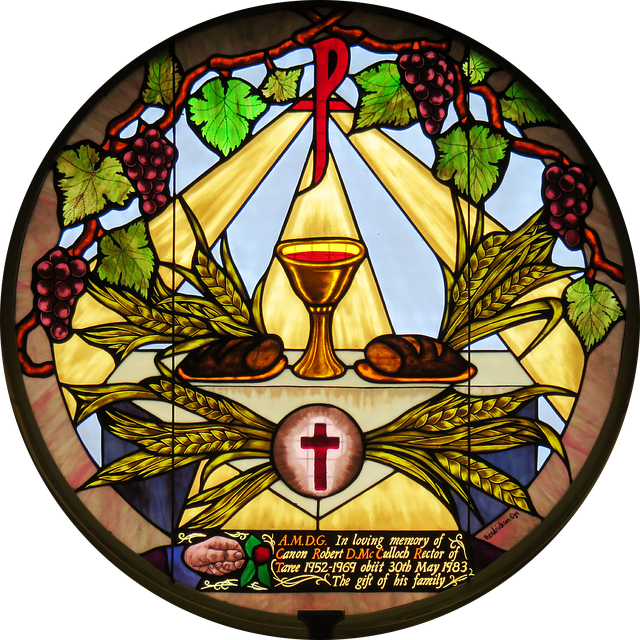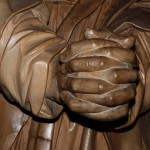I will be posting these “notes” every Monday for the upcoming Sunday. I have developed this style from my experiences at Epiphany Anglican Church in Mission Viejo, CA when I was preparing these for our two priests/preachers as part of my job. The format will be hypothesis, analysis, and synthesis. Put in other terms: I will first give you my thoughts on the theme, I will then go through the Collect and readings one at a time and then I will conclude by drawing it all together and fleshing out the theme.
Hypothesis
The lectionary is interesting as it takes us to a pericope after the Triumphal Entry on the Sunday before Palm Sunday (or the Sunday of Passion Week). Later in Lent I will be adding a post on “Lazarus Saturday” in honor of my Orthodox friends—sadly the Protestant and Roman Catholic Churches do not celebrate the Raising of Lazarus in a narratival setting the way the Orthodox do. Back to the text, we have to jump forward in our Gospel readings in order to read Jesus’ words regarding his exaltation before we can jump back to the Triumphal Entry next week.
It would appear that the common theme carried throughout these readings and the Collect is one of the New Covenant and Jesus’ mediating role as our High Priest. In short: Jesus’ death is the initiation of the new covenant through which our sins are forgiven and the law is written on our hearts. There is a beautiful phrase coming from the Hebrews passage which sums up the angle I’d like to take: reverent submission.
Analysis
Collect
This is one of my favorite collects and for me it reminds me of the work done by Jamie Smith in Desiring the Kingdom. Smith bases his work off of St. Augustine’s understanding of our desires. Simply put[1]: our desire is not in a vacuum. All desire has an object. Human desire began in creation and the only object of our desire was God; this is as it should be. However, with sin our desire became misdirected, unaligned, disordered and instead of God we found other objects and things toward which we point our desire.
Desire here is much more than affection it. It is kardias, our gut (or core) love. Through the work and person of Jesus Christ our desires can again be ordered toward God and that is the main sentiment of this collect: taming and ordering our unruly desires. To love God’s commands and to desire his promises is indeed to be a covenant-member of his family, a kingdom citizen of his already inaugurated but not yet consummated kingdom. And it is this coming Kingdom—the new heavens and the new earth—when God shall be all in all—where our true desires should be fixed.
Old Testament – Jeremiah 31:31-34
The Old Testament passage comes from Jeremiah 31:31-34 and it is a passage familiar to many. God is speaking of the New Covenant that he will establish with his people, Israel. Now, a quick word on covenantal theology: like Calvin and others I do not find the language of “old” and “new” covenant particularly useful because it can convey a picture of “Plan A” and “Plan B.” I far prefer the concept of “one covenant and two administrations.” This isn’t semantics but a deep theological conviction that guards against any sort of superiority complex or supersessionism from Christians. We must always remember that we have been grafted into Jesse’s branch—we are not Jesse’s branch out right. Soapbox message completed.
In this passage God describes what the new covenant will look like. Why a new covenant? Because Israel had repeatedly broken the covenant he established with her at Sinai. This resulted first in 40 years of wandering and finally into capture, captivity and exile. God has husband has remained faithful to his unfaithful bride. God reminds Israel of this with reference to leading her out of Egypt. In fact, that very image is the way he introduces the covenant in Exodus 20: I am the Lord your God who brought you out of Egypt. The covenant was made and the law given to a people already redeemed. A new covenant is also a promise of redemption.
This covenant gives the eschatological picture in full: I will be their God and they will be my people. This is the OT equivalent of God being ‘all in all’ found in the New Testament. This is the telos of creation; it is the redemption toward which God has been working even before he uttered the logos to create. The law shall be written on their hearts and their sins and iniquities forgiven. The new covenant—yea, the everlasting covenant—will free people not only from exile but also from the bondage of sin.
One cannot read through this section of Jeremiah without looking back to the Exodus and being mindful of her current situation: she again finds herself in exile, under foreign occupation, and she is in desperate need of her Redeemer.
The Psalm – Psalm 51:1-12 or Psalm 119:9-16
There are two choices from the Psalter for this Sunday: one speaks more concretely of sin and one of law. Both fit in with the Collect and the other lectionary readings quite nicely. Psalm 51 recounts David’s lament over his adultery with Bathsheba. He is torn up over his iniquity and asks God for forgiveness. The imagery used for such a cleansing is extremely vibrant and provides the backdrop for our understanding of being cleansed by blood. It is the last few verse that I want to draw particular attention to: David asks the LORD to “create in him a clean heart” and to “renew a right spirit” within him, finally he asks to be sustained by the Holy Spirit. This is the meaning of forgiveness from sins. It is not simply that our sins are wiped and washed away, it certainly is that, but it is also that amendment of life should and must follow. We are forgiven (or blessed) in order to forgive, to bless and to be set aside for good works. In other words, our desires are rightly ordered and flowing from such ordering is a life of worship, of obedience, of reverent submission (I’m borrowing from Hebrews early).
The other option is from Psalm 119 and this is the longest Psalm in the Psalter. The entirety of Psalm 119 depicts one’s love of the law and one asks the LORD again and again to give him desire for his commands. The Psalm for this Sunday requires little exegesis; it is not difficult to understand, simply difficult to live out! You can use Psalm 119 as an “application point” or part of your “so what?”.
Epistle – Hebrews 5:5-10
Hebrews 5:5-10 is the lynchpin for this week’s message, I believe. Here we get a picture of Jesus as High Priest (in the order of Melchizedek). We also come to our beautiful phrase “reverent submission.” The writer of Hebrews has already gone to great length to establish Jesus as not only a high priest but as the high priest in the order of Melchizedek. Your minds should go back to Abraham’s encounter with Melchizedek in Genesis 14. We do not know much of anything about this individual aside from the fact that he was a king and Jesus is a priest in his line forever. We also know that Abraham (then Abram) gave the King a tenth of what he had. He is referenced 11 times in Scripture: Genesis 14, Psalm 110 (quote in Hebrews) and 9 times in Hebrews.
We are reminded that Jesus did not glorify himself. Rather, the Father glorified him! This is the consistent message of John’s Gospel: Jesus is glorified and exalted by the Father and not by his own accord. The Father glorified Jesus due to his “reverent submission.” It was the Father who “saved him from death.” It was the Father who heard his cries and supplications, who answered his call, and who has seated him at his right hand. It is to this Father that Jesus has submitted reverently. If the second person of the Trinity, the God-man, Jesus of Nazareth has submitted himself to the Father, how much more so should we?
He was (and is) a Son and he suffered and through it learned obedience. The result? He is the source of eternal salvation! I.e. he is the Faithful Israelite through whom the Law has been kept and fulfilled and the covenant established forever. Further, he is our Great High Priest and he mediates on our behalf with the Father. In emptying himself (kenosis from Philippians 2:5-11) and through “reverent submission” we have been saved from our sins, set aside for good works, grafted into the covenant family of God and we look to the eschatological banquet. It is utterly important that we understand Jesus as Prophet, Priest and King.
Gospel – John 12:20-33
We now jump ahead of our Lenten and Passiontide narrative in order to read Jesus’ words in John 12. When we celebrate the Triumphal Entry next Sunday we will step back a day. The setting is Jerusalem at Passover. More clearly, it is Israel awaiting Passover. Jesus has entered the city—this has been his goal since coming down from the Mountain of Transfiguration.
Some Greeks approach Philip and tell him that they’d like to see Jesus. John gives us a nice set of bookends through Philip and “seeing Jesus.” For it was in John 1 that Philip went to Nathanael proclaiming they had found of whom Moses and the Prophets wrote. Nathanael responds with skepticism about anything coming from Nazareth and Philip simply says, “Come and see.” Those words ought to be echoing in your ears when you read the Greeks request of Philip, “Sir, we would see Jesus.” This is no mistake. John’s Gospel is split into 4 sections—at least that’s how modern (and pre-modern) readers have dissected it: Prologue, the Book of Signs, the Book of Glory, and Epilogue. The Book of Signs begins with John 1:19 (opening to Philip’s “come and see”) and closes with 12:50 (the close of the “Sir, we would see Jesus”).
Philip goes to Andrew and together they go to Jesus. Jesus begins with these words, “The hour has come for the Son of Man to be glorified.” Jesus moves into a short discourse about how life comes from death and the oxymoronic idea that in order to gain your life you must lose it.
We have reached our climax in the story. John devotes 12 chapters to (1-12) to a period of several years and an additional 8 chapters to the events of a week in the Book of Glory. It is HUGELY important to John that Jesus be glorified, and therefore the Father is glorified. How is He glorified? According to N. T. Wright, “God is glorified in Christ crucified.”
The result is that Jesus will be lifted high and will draw all people to himself; thus fulfilling the Old Testament prophesies that people would come from the corners of the earth to be saved.
Synthesis
Think of the Gospel lesson from Lent 4: the Son of Man must be lifted high just as the bronze serpent on the pole in Numbers. This way all who look upon him may be saved. The hour has now come for said glorification. The format of this glorification is unlike anything the Jews would have expected: humiliation upon a cross, the self-emptying of the Son, his reverent submission to the Father rather than letting the cup pass. Jesus drank that cup to the dregs. He trampled down death by death and was glorified by the Father.
Jesus’ actions were those of a reverent submission to the Father and through them he kept the covenant and grafted us into his family people.
So what? Here are three points that I’d encourage you to use:
- Lose your life.
- Reverent submission.
- Show people Jesus.
I’m not going to flesh these out for you because I think you know your own context better than I do (and honestly I think they are pretty self-explanatory!).
A life of reverent submission is one that is lost to the triune God and is one that constantly points others to Jesus, our Redeemer and Great High Priest. May he so order our desires that we would seek after him and his kingdom rather than anything else!
[1] And I do mean “simply put” because I am trying to boil 80 pages of philosophical anthropology and academic work into a few lines.











